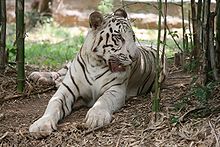Colour variations
White tigers
Main article: White tiger
T
here is a well-known mutation that produces the white tiger, technically known as chinchilla albinistic,[61] an animal which is rare in the wild, but widely bred in zoos due to its popularity. Breeding of white tigers will often lead to inbreeding (as the trait isrecessive). Many initiatives have taken place in white and orange tiger mating in an attempt to remedy the issue, often mixing subspecies in the process. Such inbreeding has led to white tigers having a greater likelihood of being born with physical defects, such as cleft palates and scoliosis (curvature of the spine).[62][63] Furthermore, white tigers are prone to having crossed eyes (a condition known as strabismus). Even apparently healthy white tigers generally do not live as long as their orange counterparts. Recordings of white tigers were first made in the early 19th century.[64] They can only occur when both parents carry the rare gene found in white tigers; this gene has been calculated to occur in only one in every 10,000 births. The white tiger is not a separate sub-species, but only a colour variation; since the only white tigers that have been observed in the wild have been Bengal tigers[65] (and all white tigers in captivity are at least part Bengal), it is commonly thought that the recessive gene that causes the white colouring is probably carried only by Bengal tigers, although the reasons for this are not known.[62][66] Nor are they in any way more endangered than tigers are generally, this being a common misconception. Another misconception is that white tigers are albinos, despite the fact that pigment is evident in the white tiger's stripes. They are distinct not only because of their white hue; they also have blue eyes.
Golden tabby tigers
here is a well-known mutation that produces the white tiger, technically known as chinchilla albinistic,[61] an animal which is rare in the wild, but widely bred in zoos due to its popularity. Breeding of white tigers will often lead to inbreeding (as the trait isrecessive). Many initiatives have taken place in white and orange tiger mating in an attempt to remedy the issue, often mixing subspecies in the process. Such inbreeding has led to white tigers having a greater likelihood of being born with physical defects, such as cleft palates and scoliosis (curvature of the spine).[62][63] Furthermore, white tigers are prone to having crossed eyes (a condition known as strabismus). Even apparently healthy white tigers generally do not live as long as their orange counterparts. Recordings of white tigers were first made in the early 19th century.[64] They can only occur when both parents carry the rare gene found in white tigers; this gene has been calculated to occur in only one in every 10,000 births. The white tiger is not a separate sub-species, but only a colour variation; since the only white tigers that have been observed in the wild have been Bengal tigers[65] (and all white tigers in captivity are at least part Bengal), it is commonly thought that the recessive gene that causes the white colouring is probably carried only by Bengal tigers, although the reasons for this are not known.[62][66] Nor are they in any way more endangered than tigers are generally, this being a common misconception. Another misconception is that white tigers are albinos, despite the fact that pigment is evident in the white tiger's stripes. They are distinct not only because of their white hue; they also have blue eyes.
Golden tabby tigers
Main article: Golden tabby
In addition, another recessive gene may create a very unusual "golden tabby" colour variation, sometimes known as "strawberry." Golden tabby tigers have light gold fur, pale legs and faint orange stripes. Their fur tends to be much thicker than normal.[67] There are extremely few golden tabby tigers in captivity, around 30 in all. Like white tigers, strawberry tigers are invariably at least part Bengal. Some golden tabby tigers, called heterozygous tigers, carry the white tiger gene, and when two such tigers are mated, can produce some stripeless white offspring. Both white and golden tabby tigers tend to be larger than average Bengal tigers.




No comments:
Post a Comment